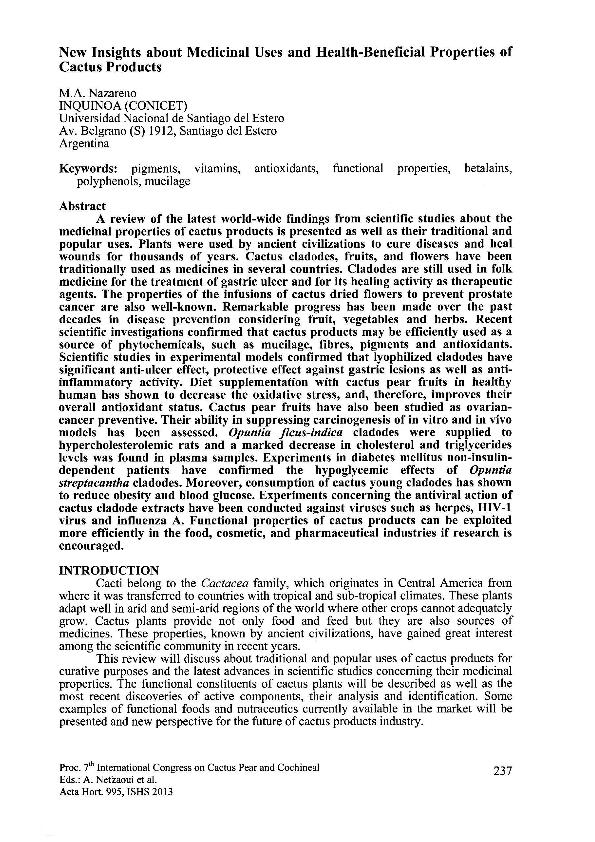Mostrar el registro sencillo del ítem
dc.contributor.author
Nazareno, Mónica Azucena

dc.date.available
2017-10-13T15:25:42Z
dc.date.issued
2013-06
dc.identifier.citation
Nazareno, Mónica Azucena; New insights about medicinal uses and health-beneficial properties of cactus products; International Society for Horticultural Science; Acta Horticulturae; 995; 6-2013; 237-250
dc.identifier.issn
0567-7572
dc.identifier.uri
http://hdl.handle.net/11336/26563
dc.description.abstract
A review of the latest world-wide findings from scientific studies about the medicinal properties of cactus products is presented as well as their traditional and popular uses. Plants were used by ancient civilizations to cure diseases and heal wounds for thousands of years. Cactus cladodes, fruits, and flowers have been traditionally used as medicines in several countries. Cladodes are still used in folk medicine for the treatment of gastric ulcer and for its healing activity as therapeutic agents. The properties of the infusions of cactus dried flowers to prevent prostate cancer are also well-known. Remarkable progress has been made over the past decades in disease prevention considering fruit, vegetables and herbs. Recent scientific investigations confirmed that cactus products may be efficiently used as a source of phytochemicals, such as mucilage, fibres, pigments and antioxidants. Scientific studies in experimental models confirmed that lyophilized cladodes have significant anti-ulcer effect, protective effect against gastric lesions as well as anti-inflammatory activity. Diet supplementation with cactus pear fruits in healthy human has shown to decrease the oxidative stress, and, therefore, improves their overall antioxidant status. Cactus pear fruits have also been studied as ovarian-cancer preventive. Their ability in suppressing carcinogenesis of in vitro and in vivo models has been assessed. Opuntia ficus-indica cladodes were supplied to hypercholesterolemic rats and a marked decrease in cholesterol and triglycerides levels was found in plasma samples. Experiments in diabetes mellitus non-insulin-dependent patients have confirmed the hypoglycemic effects of Opuntia streptacantha cladodes. Moreover, consumption of cactus young cladodes has shown to reduce obesity and blood glucose. Experiments concerning the antiviral action of cactus cladode extracts have been conducted against viruses such as herpes, HIV-1 virus and influenza A. Functional properties of cactus products can be exploited more efficiently in the food, cosmetic, and pharmaceutical industries if research is encouraged.
dc.format
application/pdf
dc.language.iso
eng
dc.publisher
International Society for Horticultural Science
dc.rights
info:eu-repo/semantics/openAccess
dc.rights.uri
https://creativecommons.org/licenses/by-nc-sa/2.5/ar/
dc.subject
Antioxidants
dc.subject
Cactaceae
dc.subject
Phytochemicals
dc.subject
Bioactivity
dc.subject
Pigments
dc.subject
Vitamins
dc.subject
Functional Properties
dc.subject
Betalains
dc.subject
Polyphenols
dc.subject
Mucilage
dc.subject.classification
Ética Médica

dc.subject.classification
Ciencias de la Salud

dc.subject.classification
CIENCIAS MÉDICAS Y DE LA SALUD

dc.title
New insights about medicinal uses and health-beneficial properties of cactus products
dc.type
info:eu-repo/semantics/article
dc.type
info:ar-repo/semantics/artículo
dc.type
info:eu-repo/semantics/publishedVersion
dc.date.updated
2017-10-12T21:21:25Z
dc.journal.number
995
dc.journal.pagination
237-250
dc.journal.pais
Bélgica

dc.journal.ciudad
Leuven
dc.description.fil
Fil: Nazareno, Mónica Azucena. Consejo Nacional de Investigaciones Científicas y Técnicas. Centro Científico Tecnológico Conicet - Tucumán. Instituto de Química del Noroeste. Universidad Nacional de Tucumán. Facultad de Bioquímica, Química y Farmacia. Instituto de Química del Noroeste; Argentina. Universidad Nacional de Santiago del Estero; Argentina
dc.journal.title
Acta Horticulturae

dc.relation.alternativeid
info:eu-repo/semantics/altIdentifier/url/http://www.actahort.org/books/995/995_28.htm
dc.relation.alternativeid
info:eu-repo/semantics/altIdentifier/doi/http://dx.doi.org/10.17660/ActaHortic.2013.995.28
Archivos asociados
